作者丨张文心
我第一次看到罗宾·克鲁卡尔的作品是在纽约大学艺术系的开放工作室上。罗宾的工作室属于比较奇怪的那种——几张大尺寸,酷似摄影师罗伯特·亚当斯(Robert Adams)的美国郊区住宅照片,配上一个小尺寸的视频,视频中是一株随一名女生弯腰而弯腰的室内盆栽。我完全无法理解,直到身旁的朋友小声和我说:“这些场景都是她做的微缩模型”。
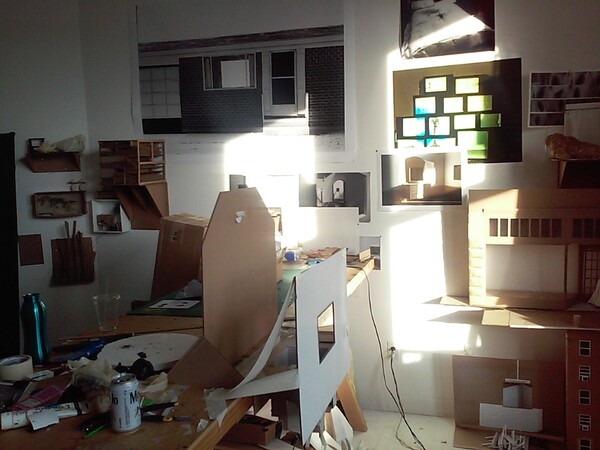
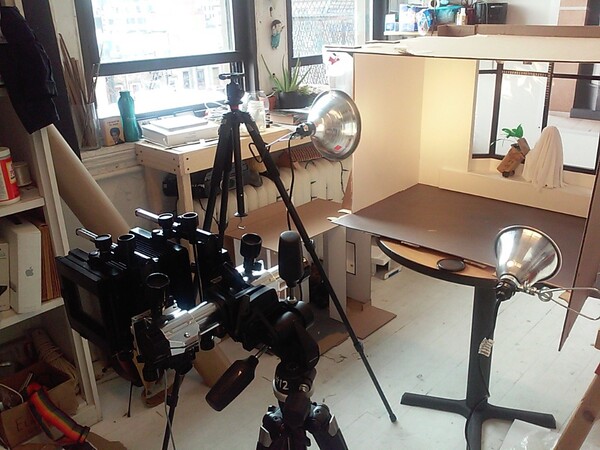
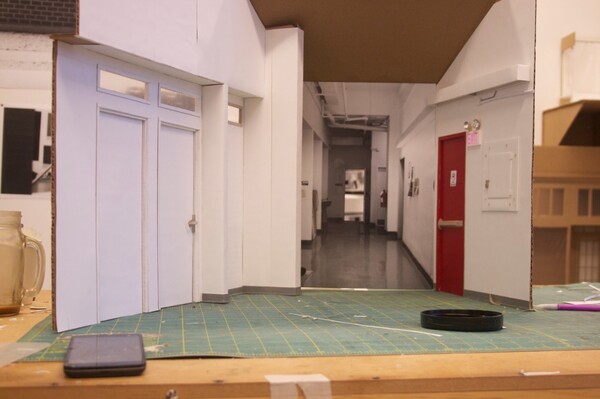
罗宾的微缩模型制作过程
第二次看罗宾的作品是在她的研究生毕业展上。在一个临街带窗的展厅中,窗台上放着一盆手工假室内盆栽,植物过于鲜艳的叶片上还有颜料涂抹的痕迹。面对着植物的是一个一人高的照片支架,照片则像镜子般一丝不苟地反射着它面前的场景。盆栽左侧墙上的屏幕中播放着同一棵盆栽跳跃的场景,而展厅的角落则是另一个幻境——一个延伸出去的虚构的房间。此时,展厅中的照片早已不是单独存在的物件,而是与展厅本身融为一体,共同制造着关于反射与不存在的幻觉。照片本身放弃了完整表意的意图,而是以一种场域特定(site specific)的方式与雕塑、录像和观看者一起构成了一个完整的空间装置。
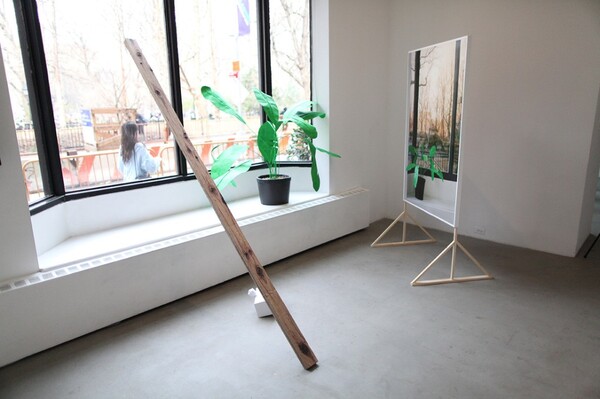
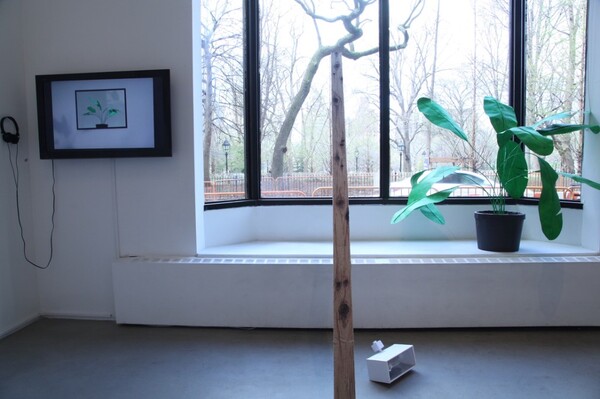
MFA毕业展现场
身为一个刚刚毕业的年轻艺术家,罗宾也面临着许多年轻艺术家共同经历着的问题,比如怎样平衡生活与创作之间的关系,以及前辈的作品对自身创作的影响。
罗宾的作品中有一种略带诡异而又刻意为之的粗糙感,而这种质感则来自于她对周遭环境与流行文化所传达的审美的解构与再造,以及一种对未完成的粗糙雕塑的偏好。罗宾的作品并非像近年来于当代艺术展览中常见的,带有数字与塑料质感的图像那样以创造新型的感官刺激为目标,而是以一种近乎稚拙的方式在无尽的平庸日常中撒入虚幻的魔法粉末,观看它们轻轻地呼吸与扭动,但不通向任何地方。
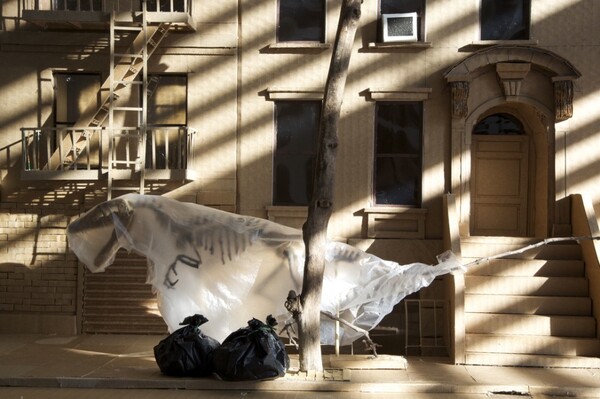
Day Trash,2014
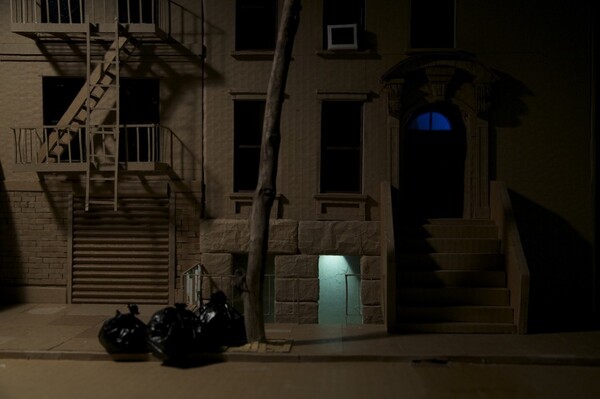
Night Trash,2014
(Z=张文心 R=罗宾)
Z:罗宾你好,很高兴可以和你做一个访谈。我知道你刚刚从纽约大学的MFA项目毕业,现在生活怎样?你能和我们描述一下你平时一周的大概安排吗?
R:研究生毕业后的生活是蛮新的经验,我仍处于过渡期。适应学校之外的生活是一个我试图去拥抱的挑战。付房租以及寻找到能让我做艺术的时间和地方是我目前的主要目标。幸运的是,我在毕业后便找到了两份半职的工作。在普通的一周里,我于周一和周五在一家小型但发展很快的制造公司上班,他们手工制作美丽的家具和设计品。我做办公室工作,帮忙保持事物的秩序和察看库存。周二到周四我在一个纽约本地的艺术家/老师约翰·皮尔森(John Pilson)处工作。他是摄影师,而我是他的工作室助理,帮他处理一系列艺术有关的项目。我用剩下的时间在布鲁克林周边骑单车,去看画廊的开幕,以及试着减少我艺术作品的体量,让它们得以装进我在Ridgewood处的小公寓。因此我猜做微缩模型对我来说是件好事。
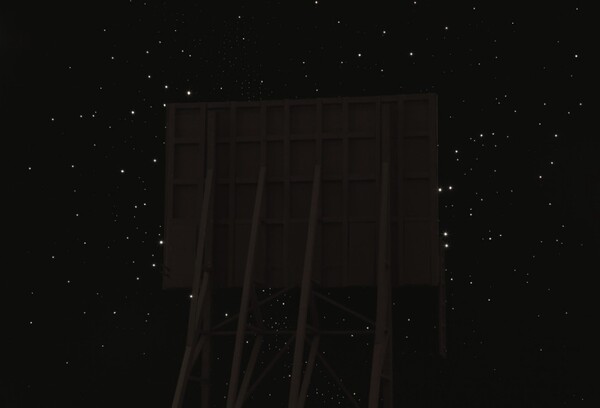
Billboard Back, 2015
Z:动物对你来说意味着什么?对我来说,我对动物的感情很复杂。人与动物之间的交流十分依赖直觉,同时又很不确定。在你的作品中,动物扮演的是什么样的角色呢?
R:我也与动物有很复杂的关系,特别是在我的作品中。我试着把这二者分开——可以说我是一个动物权益倡导者也很关心环境,但这并不是我作品中想要说的事情。虽然有时我也意识到自然世界的崩塌和人造世界的荒诞和无用,而这些正是我试着去探索的东西。我将自然引入我的作品中,比如植物和动物,并使用它们的审美特性来探讨无用感、幻象和超现实。动物的形象与微妙感也为呆板的人类世界增添了一些不错的对比。
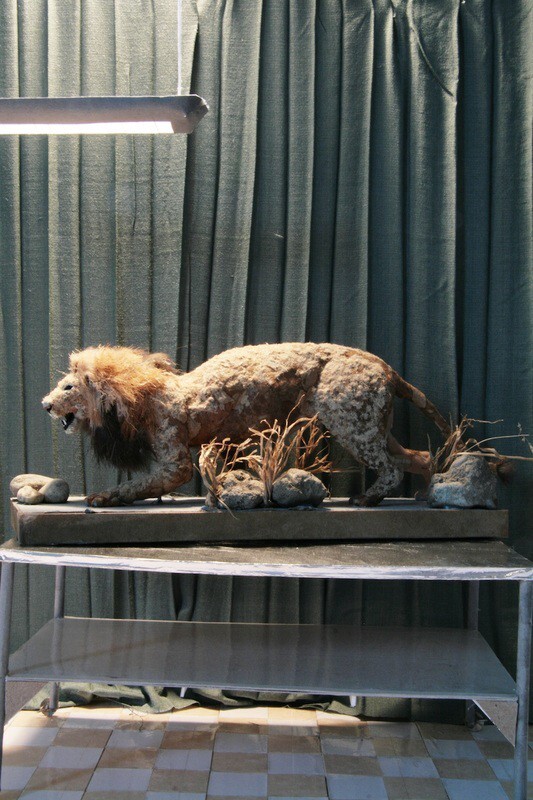
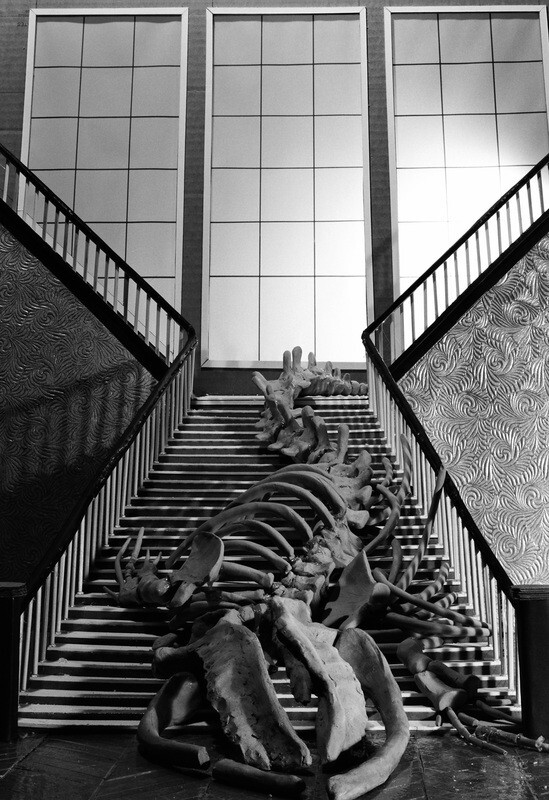
Staircase, 2013
Z:你是不是经常被拿来和托马斯·笛芒(Thomas Demand)比较?虽然你和他的作品都共同带有一种诡异感,但在细节上你们可以是完全相反的。你聚焦庸常与不完美,然而他的作品则几乎是庄严的。是什么影响了你的审美以及对质感的偏好?
R:几乎每次,至少是我在研究生院的大部分时间中都被与他对比。像你一样,我觉得我和他的作品是可比的,并且我很高兴这点,因为他是我最喜欢的艺术家之一。但我和他的区别多于相似性。我和他都制作建筑环境模型然后拍摄下来,但我觉得我们的相似性也就到此为止了。我使用不同的材料并受到不同东西的影响。托马斯·笛芒创造与被摄事物等大的,发生过重要事件的场所的模型,而我则正好相反。我制作小尺寸的模型,并且它们常常是数个不重要场所的综合。就这些场所而言,我不希望观者除了知道它是一个场所之外,有任何其他的认识。我大多时候使用卡纸和热熔胶来制作,因为这对我来说是最快捷的塑形方式,同时它恰好能使观者在信服的同时保有一些建造所遗留的线索。
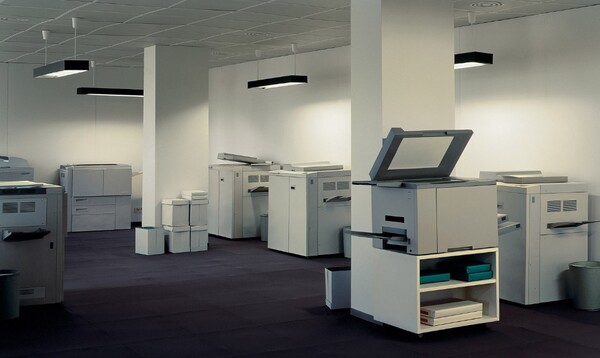
复印室,托马斯·笛芒,1999
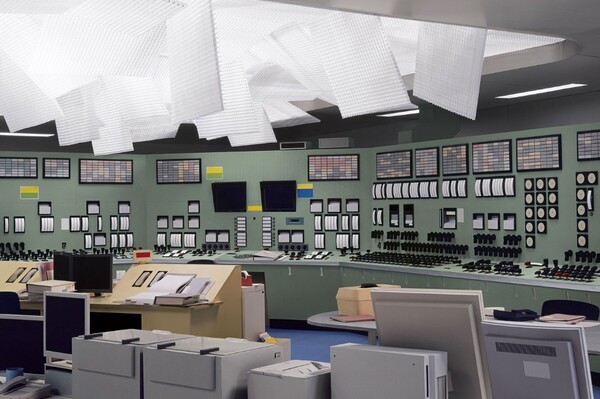
中控室,托马斯·笛芒,2011
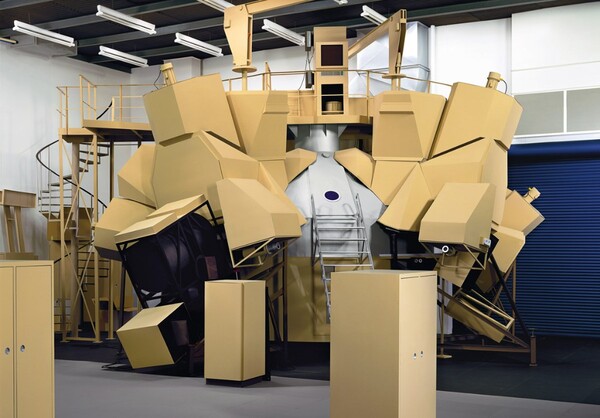
空间模拟器,托马斯·笛芒,2003
Z:为什么选择摄影呢?你如何使用摄影的平面与静止的特性来帮助你完成幻象的构建?在你的MFA毕业展上,你为什么聚焦于反射带来的幻觉?
R:在二维的平面上可以让观者按照我的意愿来观看。不像那些可以由观众在各个角度观看的雕塑,我创造了一个只能在特定角度观看雕塑的舞台。照片将我的视角赋予了观者,并让我得以控制那些小把戏。我没有那么关注“静止性”,特别是在使用视频及gif文件创作时。
我不认为我的作品是摄影,虽然这是我大部分作品的呈现形式。我喜欢装置,并且将作品更多地看成是以摄影为基座的雕塑。在毕业展中,我试着寻找一种将摄影本身作为雕塑的方法。我试着让图片变成一个更大的装置的一部分。为了让图片不再是摄影,我的方案是让它们假扮为镜子。基于反射的假象,我希望创造一个完全幻觉式的空间,其中充满了假镜子和假的物体——一个可以使观者晕头转向,迷惑不已或者使其彻底受骗的空间。
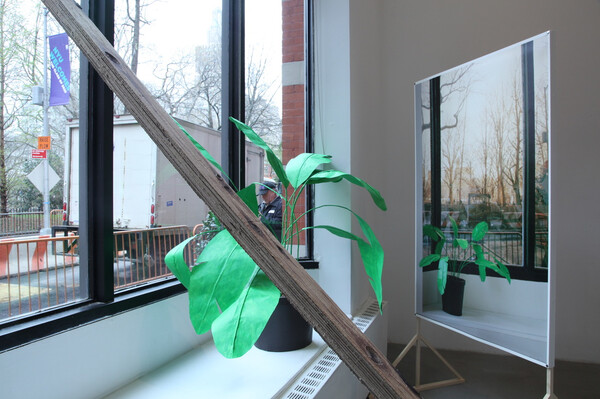
MFA展览现场
Z:在你的自述中,你说室内盆栽是“一种控制的幻觉”,这是你作品的主要关注点之一吗?你建造模型、拍摄它们并使其成为装置,那么艺术创作对你来说也是一种控制的行为吗?
R:是。呃至少我希望是这样,更确切的词可能是无用,或者荒谬。我是一个有黑色幽默的人,所以我在使用这些词的时候往往除去了其负面意义。我作品的主题和制作过程是一体的。我使用幻象来点出我们的世界中的真与幻。每个人都渴望控制,我也不例外。我总是提醒自己有多么欠缺控制力以及生活有时候是多么的荒谬,好吧我的黑色幽默感又跑出来了。但是的,控制,或者说控制的缺失是我作品的主题,对此最好的佐证便是我对拍摄环境彻彻底底的把控。
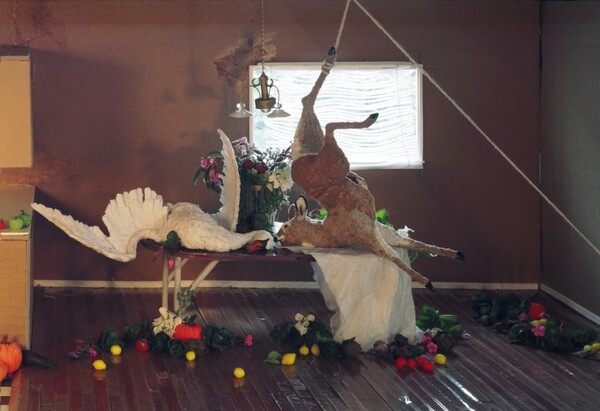
静物,2012
Z:在你的作品中有许多的幽默成分。在“Jump”和“Bend”两个作品中,你让室内盆栽变成会动的布偶,而在“Baby Girl”系列里,你钻进海象服中让海象变成室内动物。为什么你让植物变得像人而人像动物?
R:你已经瞭啦,我这么做就是因为好玩!喜剧经常启发我,我想让它成为作品中更加重要的部分。我大多数作品看上去可能并不好笑但在它们深处总有一些荒诞的成分。作为一个艺术家,就像是在做对不存在的,但你希望其存在,然后让它们存在的实践的一种探索。抱歉这可能没有回答你植物或者海象的问题呃。它们都以不同的方式和我一个叫做“与自然一体”的概念相联系,即我会寻找和自然成为一体的不同方式,并展现出人们在尝试这么做时的无力感。
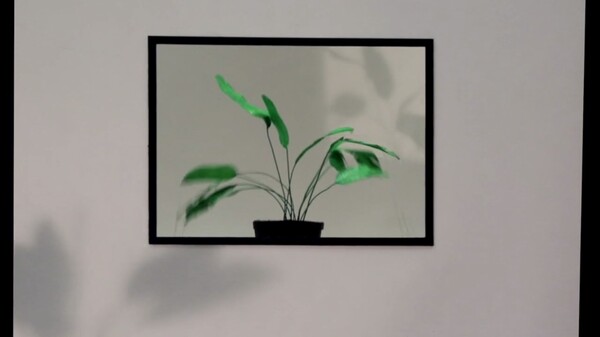
Jump,2015
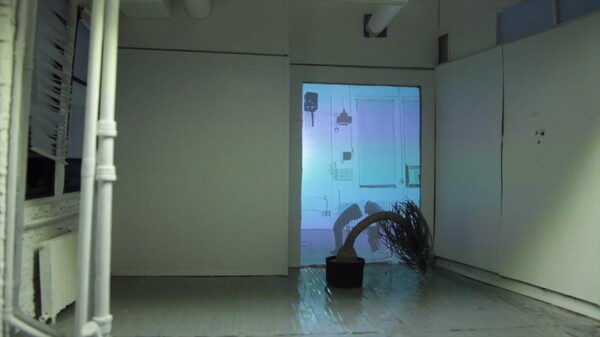
bend,2015
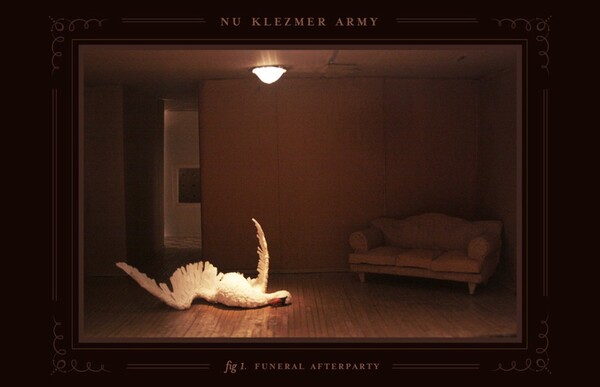
聚会后的葬礼,2014
Z:在你的模型里,你似乎倾向于构建一些特定类型的地点,像是住宅,艺术工作室,和自然历史博物馆。你描述过:“我使用住宅或房间为对象是因为它即是人所熟悉又是安全的……它时常因为日常而被轻视,就像是旧情人。”你是否容易被看起来略微过时(obsolete)的场所吸引?除了这些,你在建造模型的时候有参照其他摄影师更早的作品吗?(比如罗伯特·亚当斯的美国房屋照片和杉本博司的自然历史博物馆照片)
R:过时(obsolete)是个极好的词,我也会使用“庸常”或者“乏味”。因为我想要创造幻象而非魔法,所以对微妙感的轻巧处理就变得极重要。
我绝对在灵感和学习的方面参见了其他艺术家。罗伯特·亚当斯这个你说得太准了。我曾经完全模仿过它的两幅作品,我相信我们都是从模仿中学习。通过模仿他的作品我学到了光线和景深的一大堆东西。就杉本博司来说,我很喜欢他的照片,但在我做有关标本的作品时我其实在看理查德·巴恩斯(Richard Barnes)的作品。我觉得只要你对人类与自然之间的交界部分感兴趣,自然历史博物馆就绝对是个学习的绝佳场所。
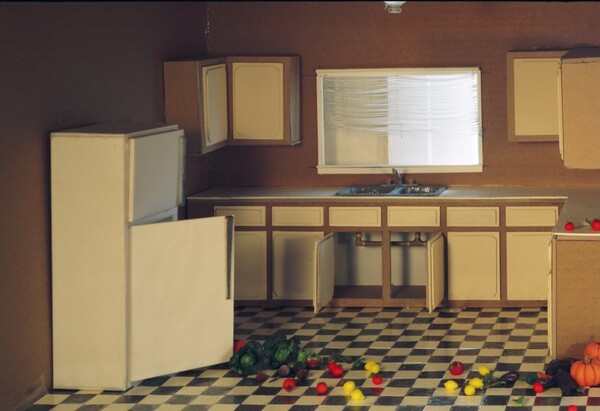
静物,2014
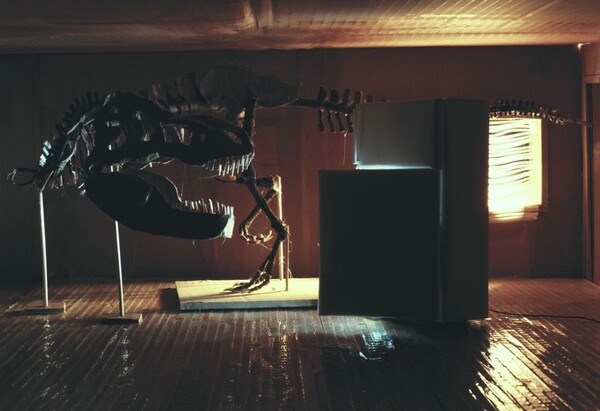
Zule,2012
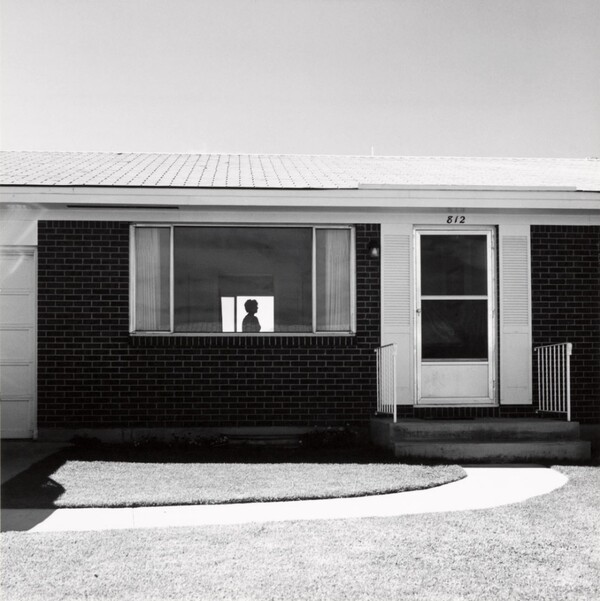
From the New West,罗伯特·亚当斯
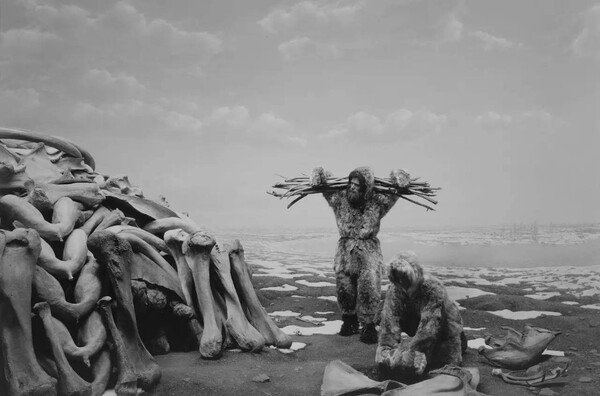
自然历史博物馆 系列,杉本博司
Z:你的作品里是否也有受到恐怖电影和和定格动画的影响?我超爱杨·史云梅耶(Jan Svankmajer)和奎氏兄弟(Quay Brothers)。还有超自然力量呢?
R:绝对的,我好开心你从我作品里看出来了这些元素,这说明我做对了!说不上是恐怖吧,我更喜杨史云梅耶和奎氏兄弟动画中超现实和诡异的元素。我也很喜欢他们动画中的微缩模型与人偶。我自认为是一个外星人、超自然力量和阴谋论的拥护者。相信有真实的外星人造访地球这点就曾在我的作品中体现出来。你有没有看过《远古外星人》?那个电视片简直就是我的圣经。我喜欢好的神秘故事以及未解之谜。
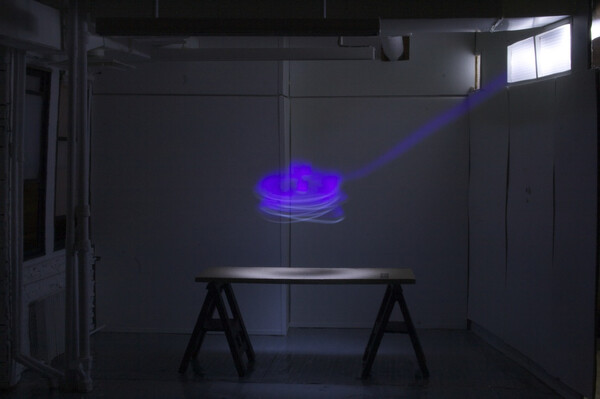
外星人,2015
Z:你经常为模型拍摄两个版本,即“白天”与“黑夜”。你为什么要营造不同的时段呢?
R:我是有几张演变为双联画(diptych)的作品,一张白天一张黑夜。我曾经不愿意让作品中有偶然的差错,或者说失去控制力。你所看到的每件作品都是我经过了特别的计划,打草稿,建造然后拍摄的。在建造之前我心里已经有了特定的拍摄角度和光线安排。然而我工作室中的自然光会给我制作的模型投上计划之外的影子。然后我就开始在建造时尝试使用这种偶然性,并给新的发现留有空间。所以这些作品是我试图让我的模型超越我本来的意图,而得以呼吸,并拥有其自己的生命的一种尝试。
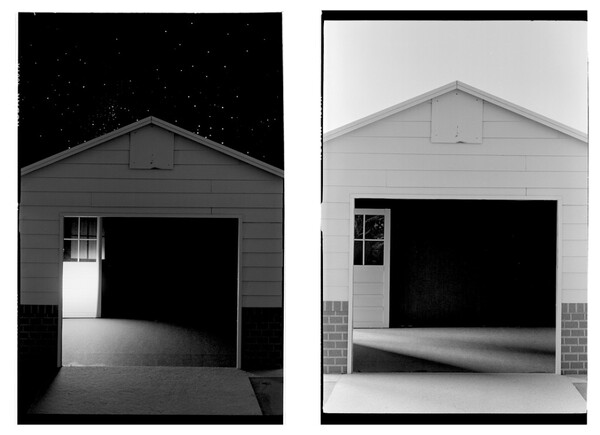 Night Garage,Day Garage,2016
Night Garage,Day Garage,2016
Z:你最喜欢那些艺术家的作品?你最近有看到喜欢的展览吗?
R:我很喜欢罗德里格·瓦伦祖拉(Rodrigo Valenzuela)的作品,你采访过他(查看原文)。他在去年是我作品的一个很大的影响。巧合的是我在华盛顿大学读本科的时候他那时候在同一个学校读研究生。
我也很喜欢戈登·马塔·克拉克(Gordon Matta Clark),以及Fishli/Weiss(瑞士艺术双人组彼得·菲茨利与大卫·怀斯)的作品。前阵子在古根海姆美术馆的Fishli/Weiss的展览“How to Work Better”,绝对是我去年看过的最好的展览之一。我本科学的是陶瓷,所以我对黏土有特殊的感情。我很爱汤姆·萨克斯(Tom Sachs)的作品,特别是他在复制东西的时候对材料和物品的选择上。还有他的录像作品Waffle Bike,让我笑到哭。我最近开始喜欢尼尔·哥德堡(Neil Goldberg),特别是他在录像中对幽默以及动物的使用。

Splitting and the Unmade House,Gordon Matta-Clark
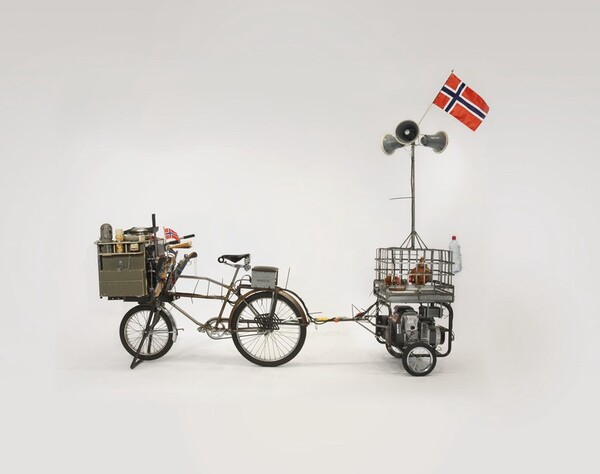
Waffle Bike,Tom Sachs
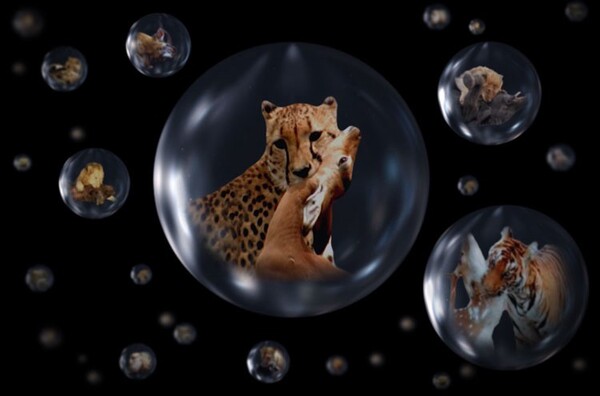
Still from the video One Version of Events No. 3 (2015),Neil Goldberg
Z:你可以给我们推荐点什么吗?书影音之类的。
R:《Play Time》,作者Jacque Tati。
《Pure Drival》作者Steve Martin,一个好笑的短故事集。
《2001太空漫游》,当然我相信你们都已经看过了。
大卫林奇的《橡皮头》。(很惭愧这个我直到最近才看)
Ladislas Starewicz的早期停格动画作品《The Mascot》以及他的《Tale of the Fox》,去找找海狮Wedler 发出的声音听,特别迷幻。
《UFO’s Generals, Pilots and Government Officials Go on the Record》,作者Leslie Kean。(幽浮信徒必看)
Avery Monsen的Vine账号,我的神,我简直没法描述这个人。
以及John Karel制作的很酷的gif 图,包括了骷髅和植物的元素。
作者简介
张文心(她的图虫主页)于1989年出生于安徽合肥,现工作生活于中美两地,她于2013年获得美国加州艺术学院纯艺术硕士学位。张文心的作品探讨现实与虚构的界限,以多种叙事手法创建章节式的视觉小说。张文心曾获得徕卡新人奖和三影堂摄影奖提名,并获得马格南Atlantic Philanthropies项目奖金,并曾在旧金山瑞柯摄影中心和伍德斯托克摄影中心驻地。
Hello Robin, it’s a pleasure to interview you. I know you just graduated from NYU MFA program, what’s life is like now? Could you describe a typical week on your calendar?
Life outside grad school is still pretty new. I am definitely in a place of transition. Having to adjust to life outside school is a challenge, but one in which I am trying to embrace. Paying rent and finding the time and place to make my art, are my top priorities at the moment. I was fortunate enough to land two part time jobs since graduating. In a typical week I work Monday and Friday for a small, but growing, fabrication company that specializes in beautifully hand-crafted furniture and design. I work in the office, helping to keep things organized and inventoried. Arguably not my specialty but working around creative types is always inspiring. Tuesday - Thursday I work for a local NY artist and teacher, John Pilson. He is a photographer and I work as his studio assistant, helping with a variety of art related project. The rest of my time is spent cycling around Brooklyn, going to gallery openings, and downsizing my studio practice to fit into my small Ridgewood apartment. I guess it is a good thing I work in miniature!
What do animals mean to you? For me, I have very complicated feelings towards them. Animal-human communications are very instinctual and uncertain. And what roles do the animals play in your work?
I too have a complicated relationship when it comes to animal and especially when it come to animals in my work. I try to keep the two things separate. I would say I am an animal advocate and care about the environment quite a bit, but these are not things I want to talk about in my work. My work is not about animal rights or conservation, although I do find the collision of the natural world and man made world to be quite absurd and futile at times, and those are subjects I am trying to explore. I pull nature into my work; i.e. plants and animals, for their aesthetic ability to talk about futility, illusion and the surreal. The shapes and nuances of animals also add a nice contrast to the stif realm of the human constructed world.
Have you been compared a lot to Thomas Demand? I think although your and his work share the uncanny character, but in details you can be totally opposite. You embrace the mundane as well as the imperfection, while his work is almost sublime. What contributes to your aesthetic as well as material preference?
Only, all the time, or at least most of my time in grad school. It seems like every studio visit I have with someone new, Thomas Demand does come up. Like you, I do think our work is comparable and I am happy to be compared with him, as he is one of my favorite artists. But I do think we have more differences than similarities. We both create architectural environments that we capture with photography, but I think our similarities end there. I work with different materials and far different influences. While Thomas Demond creates life size replicas of places where important events took place I do the opposite. I create small scale models and they are usually a combinations of unimportant places. These places are not ones in which I want my viewer to recognize other then that “know”, it is, a place. Although my earlier work definitely references the surreal, I’d say my recent work tries to talk about illusion; What we think is “real” vs reality. I use mostly cardboard and hot glue to build with, because it is the quickest, easiest way for me to sculpt and I find that I can manipulate the material just enough to be convincing to my viewers while still leaving behind clues of its construction.
Why photography? How do you utilize the flatness and stillness of photography to help you achieve the “tricks”? What made you focus on the illusion of reflections in your MFA show installation?
On the 2-d plan I am able to put my viewer exactly where I want them. Unlike a sculpture that allows one's viewer to walk around and look under and over their installation. I have created the stage and the exact angle of how you will view my sculpture. This allows me the freedom to control the light and atmosphere. The photograph allows my installations to be viewed from my perspective. The photograph allows me the control to perform my tricks. I am not as interested in the “stillness”, necessarily, especially as I explore videos and gifs within my practice.
I don’t see my work as photography, even though that is how most of the work is presented. I love installation and view my artwork more as sculptures that use the photograph as a pedestal. For my thesis show I tried to find a way of using the photograph itself as a sculpture. The photos became part of a greater installation, in my attempt to make them into something other than photographs. My solution to this was to try and make them mirrors. With the illusion of reflection, my desire was to create an entirely illusionist space, with fake mirrors and fake objects; A space that might disorient, confuse or fully fool my viewer.
In your statement, you described houseplants as “an illusion of control”, is this a major theme in your work? You build the models, photograph them and then make them into space installations, is art making also a process of control to you?
Yes, well at least I want it to be, a better word I guess would be futility, or absurdity. I also have a dark scenes of humor so I use these word without the negativity normally associated with them. The process and the themes are definitely linked. I am using illusion to highlight the illusions in our “real” world. Everyone wants control, and I am no different. I have to constantly remind myself just what a lack of control I have and how insignificant and ridiculous life can be sometimes, ok there is my dark scenes of humor again. But yes, control, or lack thereof are themes in my work and what better way to express that to have my process be on in which I completely control the environment that I photograph.
There’s a lot of humor in your video works. In “jump” and “bend”, you make house plant models into puppets that act almost like human beings. And in your “Baby Girl” series, you crawl into the walrus suit and act like a domestic walrus. Why do you enact plants as humans and human as walrus?
Well you nailed it, I do it because it is funny! Comedy is something that inspires me and I would like to have as more of a central part of my work. Most of my photographs may not seem funny but they all have their roots in something that at least to me is absurd. I am a huge fan of Steve Martin’s stand up, maybe this can help answer your question. Being an artist is an endless search for thinking of things that don’t exist, that you want to exist, and then making them exist! Sorry there is not a better answer to why plants or why the walrus. They both came about in vastly different ways but can be connected with the idea I had for a body of work called “One With Nature”; in which I would find different ways of being one with nature and expose the absurd and futile ways that humans attempt to do this.
In your models, you seem to focusing on constructing specific types of locations, like homes, art studios, and natural history museums. You described: “I use the subject of the home or room because it is familiar and safe… It’s underwhelming and routine, like an old lover.” Are you attracted to places that look a little obsolete? Besides that, do you refer to earlier photographer’s works when constructing places? (Like Robert Adams’s American houses and Hiroshi Sugimoto’s natural history museum)
Obsolete is a great word, I would use mundane or boring as well. Because I am trying to achieve illusion rather than magic, subtly or slight of hand, becomes extremely important. I absolutely refer to other artists for my education and inspiration. You totally got me on Robert Adams. I can’t lie that I straight up tried to copy two of his photographs. I believe that we learn from copying things. I learned a whole lot about lighting and depth just from trying to mimic Adam’s work. As for Sugimoto, I do love his photographs but at the time that I made most of my taxidermy work I was actually looking at the work of Richard Barnes. I didn't know of Sugimoto until later. I think whenever you're interested in the intersection between man and nature, the natural history museum becomes a particularly fascinating place to study.
Is there also an influence of horror films or stop motion animations in your works? I love Jan Svankmajer and Quay Brothers. How about supernatural powers? (Like in the work “Alein”)
Absolutely, all of the above and I am flattered that you got that from my work, that means I am doing something right! I wouldn't say horror as much as i'd say I do like the surreal and uncanny constructions of Jan Svankmajer and the Quay Brothers films. I am also attracted to their works for their use of miniatures, stop motion and puppetry. I am also a self prescribed alien, supernatural and conspiracy theory believer. I think the fact that I believe in actual aliens visiting earth does tend to creep into my work. Have you ever watched Ancient Aliens!? That TV show is pretty much my bible. I am also a big fan of a TV show called Ghost Hunters, as well as the podcast Sasquatch Chronicles. I love a good mystery and the tales of the unexplainable. I also am intrigued by the way these film makers use sound, something I rarely use in my own work but am inspired by their work to do so.
You often shoot the model in two ways, “daytime” and “night time”. What does the time of the day mean to you in your work?
I do have a couple pieces that have morphed into diptychs, with one being night and the other day. This came about because of my past reluctance to allow for “happy accidents” into the work. Or in other words my resistance to losing complete control. Each piece you see usually came from a very specific vision, that was then sketched out, built and photographed. I usually always have the angles and specific lighting in mind for each piece before it is built. I rarely allow things to change. These “night” and “day” pieces came about because of the natural light in my studio falling upon my sculptures at different time of the day, literally casting shadows on things that were not in my original vision. I am trying to build more space in my work for spontaneity and new discoveries during the construction process. These pieces are my attempts to let my sculptures, breath and have a life of their own beyond my original intentions.
What are the artists’ works you like the most? Is there any recent art shows you like?
I am very interested in the work of Rodrigo Valenzuela, I believed you mentioned him as a recent artist you did a piece on. He has been very influential in my work in the last year. Coincidentally he was getting his MFA at the University of Washington at the same time I was getting my BFA there.
I am also inspired by the work of Gordon Matta Clark, and Fishli and Weiss. The Fishli and Weiss show, How to Work Better, at the Guggenhiem was definitely one of the best shows I have seen this last year. I actually got my BFA in ceramics and still have a special place in my heart of clay. I love the work of Tom Sachs, especially his choice of materials and objects that he replicates. Also his video piece Waffle Bike, makes me laugh till I cry. I am a recent fan of Neil Goldberg, especially for his use of humor and animals in his videos.
Can you recommend us something? Like books, movies, music, etc.
All Jacque Tati’s films, but especially Play Time. UFO’s Generals, Pilots and Government Officials Go on the Record, a book by Leslie Kean. For any ufo fan, it has some amazing accounts and has only furthered by belief in extraterrestrials. Pure Drival, is a book by Steve Martin. It’s a book of short funny stories. 2001 Space Odyssey, but I am sure everyone has seen that. Most recently, and I am embarrassed to say I never saw it until a week a ago, David Lynch’s Eraser Head. This film just about blew my mind, no pun intended! The Mascot by Ladislas Starewicz is one of the earliest stop motion animations and it is fantastic, also his, Tale of the Fox. They are both beautiful and mind blowing in their creation. Now I am on a role. Look up the sound the Wedler seal makes, it is super psychedelic. And then there is the Vine of Avery Monsen. Holy cow, I don’t even have words for this guy. This guy John Karel also makes pretty rad gifs, involving skeletons and plants.
艺术家网址 Artist’s website: